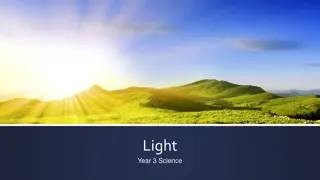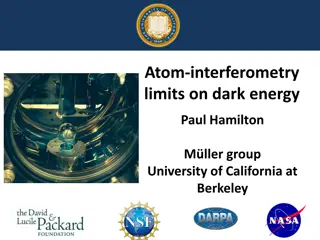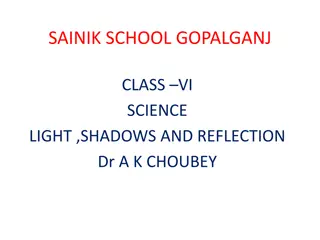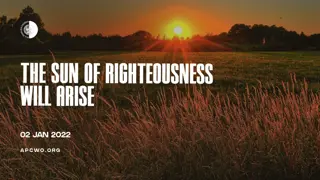
Solar Power Advancements and Challenges
"Explore the history and advancements in photovoltaics, from the discovery in 1839 to present-day output of over 600 GW. Learn about the two main types, costs, end-of-life issues, and the urgent need for action due to environmental concerns associated with solar panel disposal. Discover the complexities and environmental impacts of the photovoltaic industry."
Download Presentation

Please find below an Image/Link to download the presentation.
The content on the website is provided AS IS for your information and personal use only. It may not be sold, licensed, or shared on other websites without obtaining consent from the author. If you encounter any issues during the download, it is possible that the publisher has removed the file from their server.
You are allowed to download the files provided on this website for personal or commercial use, subject to the condition that they are used lawfully. All files are the property of their respective owners.
The content on the website is provided AS IS for your information and personal use only. It may not be sold, licensed, or shared on other websites without obtaining consent from the author.
E N D
Presentation Transcript
THE DARK SHADOWS OF THE JOLLY GREEN GIANTS Week IIb Dr Keith R. Skene BIOSPHERE RESEARCH INSTITUTE www.biosri.org
A brief history 1839: Photovoltaics discovered 1883: First solar cell developed 1954: First modern panel developed by Bell Labs 1956: Western Electric begins sales
17 March, 1958: Vanguard I launched first solar powered satellite and still in orbit
Edmond Becquerel The photovoltaic effect
Two main uses: UTILITY DISTRIBUTED
Two main types: Cadmium telluride Crystalline silicon High efficiency Flexible and less expensive
Costs: Cadmium telluride Crystalline silicon Release of silane gas, silicon tetrachloride and chlorosilane gas Release of silicon dust Energy intensive process 80% of silicon is lost in extraction process Release of Cd (carcinogen) Tellurium shortage Other costs: Utility panels require large amounts of land, and use large amounts of transformer oil
End-of-life issues Hugely complex due to heterogeneity of very different materials Require vast amounts of organic solvents Si recycling results in organic liquid waste Damage from recycling means there is little advantage environmentally Silver and REMs also being lost.
Short lifetime (25 years) means urgent action needed By 2050, 70-80 million tons per year The bulk of panels end up in landfill, much like wind turbines Here, dangerous chemicals leach out into groundwater 15% of lead leaches out in first 56 days 73% of Cd 21% of Te Molybdenum another serious leachate
Distributed PVs After 25 years, house may have been sold on New owner won t know what to do No organized central EoL programme in place
Passive solar heating and cooling Winter: sun warms building Summer: overhang shades building The sun side and floors have heat-absorbing materials (adobe and tiles) that re-radiate heat at night Deciduous plants: shade in summer, leafless in winter
Early urban planning By 2000 BC, Chinese urban planners had all streets aligned East to West, meaning that every resident had a south facing frontage to their home Ancient Greece also designed with passive solar warming in mind
2,300 years ago Socrates began the concept of retro-fitting re-organizing homes to have the must important rooms facing south. Now in houses with a south aspect, the Sun s rays penetrate into the porticos in winter, but in the summer the path of the Sun is right over our heads and above the roof, so that there is shade. If, then, this is the best arrangement, we should build the south side loftier to get the winter Sun and the north side lower to keep out the winter winds.
Aeschylus (524-455 BC) father of tragedy The great playwright Aeschylus wrote: though they had eyes to see, they saw to no avail; they had ears, but understood not. They lacked knowledge of houses turned to face the sun, dwelling like swarming ants in sunless cavities.
The Romans Used glass and mica to trap heat Established the sun-right laws everyone had the right to access to sunlight and a southern prospective. The right to light
The medieval doctrine of Ancient Lights If a window has had natural light and air for over 20 years, no new build, nor wall nor tree can interfere with that light Recent California law allows trees to be cut down that shade solar panels if they were planted after the panels were fitted.
Solar chimneys, or roofs are utilized to cool or heat buildings, avert all of the supply chain and end-of-life issues identified for active solar heating and cooling (Chan et al., 2010; Hastings 2020).
Trombe Wall Trombe Wall/Solar Chimney
Termite mounds Eastgate, Zimbabwe
St Kilda and the new tin roofs
Social justice Many such non-mechanical approaches can be found in nature and in pre-industrial architecture. Such structural solutions: do not require power to run them, can be retrofitted and should be examined in terms of energy efficiency and social justice avoiding fuel poverty.
Main policy recommendations Urgent, fundamental re-examination of recyclability of modules and supply chain issues; regulations placing utility PV facilities on brown space; implementation of a clear, easy route for distributed PV module recycling; research into improving the extraction of silicon Urgent re-evaluation of use of cadmium Compulsory inclusion of passive heating/cooling in architecture.






















